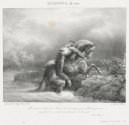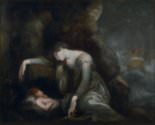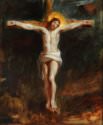Illustrations to the first French translation of Johann Wolfgang von Goethe’s Faust
Illustrations to the first French translation of Johann Wolfgang von Goethe’s Faust
Published by Charles Motte, Paris
I saw here a play about Faust which is the most diabolical thing imaginable. . . . It is an adaptation of Goethe’s Faust. . . . They have made it into an opera with a mixture of broad comedy and some extremely sinister effects.
—Eugène Delacroix, letter to Jean Baptiste Pierret, London, June 18, 1825
Hailed by Wolfgang von Goethe as “surpass[ing Goethe’s] own vision,” these lithographic illustrations by Eugène Delacroix provide a gruesome visualization of the ominous tale of Faust, a man who sells his soul to the devil, Mephistopheles, in exchange for infinite knowledge and worldly pleasures. The story of Faust originated as a medieval German folktale. Christopher Marlowe was the first writer to bring it to the stage, in a 1604 adaptation of the story. But it is Goethe’s 1808 version that is still today considered the classic. Delacroix’s masterful exploitation of lithographic techniques—such as jaggedly scratching through deep blacks to create “nervous” white highlights—expressively reinforces the sinister message of the tale, as do the relentless night scenes and the angular, insect-like limbs of the characters.




